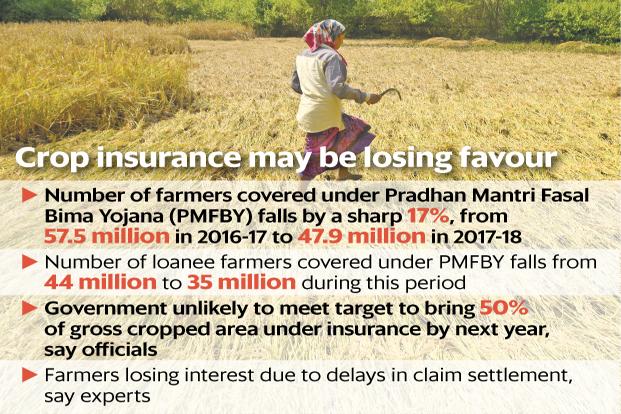Despite the centre pumping more funds into its flagship crop insurance scheme, coverage among farmers is on the decline, according to figures released on Tuesday, indicating a decline in interest among farmers.
The number of farmers (or farm holdings) covered under the prime minister’s crop insurance scheme fell to 47.9 million in 2017-18, from a high of 57.5 million the year before, a sharp decline of 17% in just a year, the government informed the Lok Sabha on Tuesday. The data further shows that while coverage among loanee farmers fell to 35 million in 2017-18 from 44 million the year before, coverage of non-loanee farmers fell marginally from 14 million to 13 million during this period. In 2016 and 2017, overall, the south-west monsoon which irrigates over half of India’s crop area was near normal, meaning rainfall had little role to play in determining insurance uptake by farmers. While the total number of holdings declined sharply over the past year, gross premium collected by insurance companies in 2017-18 is estimated at Rs24,352 crore, up 9.8% from Rs22,180 crore the year before, the government told the Rajya Sabha on 9 March. “It is unlikely that insurance coverage in terms of gross cropped area will improve in 2017-18 over the 30% coverage achieved in 2016-17,” said a top official with an insurance company who did not want to be named. “Achieving the government’s target of covering 50% of gross cropped area by 2018-19 will be a herculean task,” the person quoted above added. The official said that less than 40% of the premium due from state governments has reached insurance companies and that farmers are suffering due to the delay. Interestingly, the centre is yet to calculate the total claims filed by farmers in the current year ending March (2017-18), indicating long delays in settlement of claims. “The growth rate in agriculture credit fell sharply in the past few years... and due to rising indebtedness and delays in loan repayment by farmers expecting to benefit from loan waivers, it could be that banks are issuing less fresh loans. This could be bringing down the number of loanee accounts and therefore, the (mandatory) crop insurance enrolment numbers,” said Himanshu, associate professor of economics at Jawaharlal Nehru University, Delhi. Himanshu added that the scheme is also failing to interest non-loanee farmers due to delays in claim settlements. Studies released by Delhi-based think tank Centre for Science and Environment in July 2017, and another last month by the Indian Council for Research on International Economic Relations, Delhi, showed that the Prime Minister’s crop insurance scheme is beset with problems like delays in assessment of crop loss and claim settlement, high actuarial premiums charged by insurance companies, and lack of officers monitoring a scheme which gets as much as a third of the budget of the department of agriculture (Rs13,000 crore budgeted in 2018-19). Source - http://www.livemint.com
ScaleAgData Stakeholder Engagement Event
22.10.2024The ScaleAgData project is pleased to invite you to our second stakeholder event. Building on the discussions and connections formed during our first webinar, this event will focus on fostering collaboration among stakeholders, providing updates on our project’s progress, and outlining future opportunities for engagement.

South Korea grapples with surging prices for livestock, processed foods
Livestock and processed food prices in South Korea have soared, fueled by multiple factors including currency depreciation and rising raw material costs, further straining residents' cost of living.

Tanzania roles out national livestock vaccination, identification campaign
The government is set to launch a nationwide livestock vaccination and identification campaign on June 16, 2025, aimed at boosting animal health and opening up access to regional and international markets.

India - Growers welcome Centre's move to include tea in weather insurance scheme
Tea growers hailed the government's decision to bring the sector under the Restructured Weather Based Crop Insurance Scheme (RWBCIS), which they said would help mitigate losses due to erratic rainfall and rising temperatures.

Storm Wutip triggers floods, landslides, and crop losses across central Vietnam
Heavy rains triggered by Wutip, the first storm to enter Vietnamese waters this year, have caused landslides, severe flooding, and extensive crop damage across central regions including Quang Tri, Hue, Da Nang, and Quang Nam.

USA - Winds up to 80 mph, ‘gustinadoes’ in northern Iowa storm
Wednesday’s storm that hit Sibley and other areas of northwest Iowa caused damage to crops, trees, buildings and power lines, but Peter Rodgers, a meteorologist at the National Weather Service office in Sioux Falls, says videos of the storm posted online do not show it was a tornado.

USA - Commercial bee colony collapse threatens Washington apple, berry agriculture
Hundreds of flatbed loads of honey bees are trucked into Washington every spring, enabling the production of apples, cherries, pears and berries in the state.

WorldFish launches USD 10 million genetically improved tilapia project in Kenya
A USD 10 million (EUR 8.8 million) fish-farming project has launched in Kenya, focusing on expanding farmers’ access to genetically improved strains of tilapia.

Limits on moving livestock into Wales due to virus
Limits are to be placed on moving livestock from England into Wales in response to the spread of the bluetongue virus.





